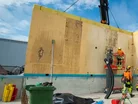Metsä Wood launches new sustainable element for construction

The innovation designed by Metsä Wood and its partners combines concrete with Kerto laminated veneer lumber (LVL). It comes with lightweight properties which have proven to be valuable in the first construction project at Metsä Fibre’s Rauma sawmill.
By combining concrete and Kerto LVL, the hybrid sandwich wall element provides an easy way to replace typical concrete sandwich elements. This is a particularly popular wall element found in residential multi-storey buildings in Nordic countries, Metsä Wood’s element can be used in residential, office or industrial multi-storey buildings.
Jussi Björman, Director at Metsä Wood said: “The hybrid construction helps to increase the share of wood to build more sustainable buildings efficiently. This joint development is our effort to support the construction industry.”
Metsä Wood collaborated with JM-Rakenne Oy, Peikko Oy, and Arkta-Reponen Oy to design the optimal hybrid sandwich wall element which is set to improve sustainability in construction and its global potential is huge.
Björman also commented on this, he said: "Metsä Wood currently works with European and Australian companies to produce similar ideas that fit the local way of construction. Half a dozen designs are being prepared for publication this year."
Tackling sustainability in the construction industry
There is an acute need for more sustainable solutions in construction; the industry causes 30% of all CO2 emissions.
"As Kerto LVL is a light material, the hybrid sandwich wall elements will be faster to produce at the factory and transport to the site, and even the transport emissions will decrease due to the lighter load," commented Björman.
He also highlighted that new, easy-to-produce construction solutions are needed to turn the industry in a more sustainable direction.
“Hybrid construction allows to reduce construction-related CO2 emissions and in addition, it created long term carbon storage. For example, 30,000 tons CO2 eq. emission reduction and 95,000 tons of carbon storage, in CO2 eq., can be achieved when one million square meters of hybrid sandwich elements are used,” added Björman.
Metsä Wood’s hybrid wall element in practice
Metsä Wood’s goal was to design a practical element, which is easy to produce and use in construction. The first hybrid sandwich wall elements were produced at Lipa-Betoni's factory in Pieksämäki, Finland, for Metsä Fibre's Rauma sawmill construction project.
With $200mn in investment, Metsä Fibre's new Rauma sawmill is the largest sawmill investment ever in Finland. As it happens, it is also the first construction project where the new hybrid sandwich wall elements are used.
Installed just this year, the elements are used in the sawmill’s log sorting building. This installation was successfully completed and took five hours to assemble the elements.
The new, hybrid sandwich wall element design is already available at the Open Source Wood platform, which aims at facilitating knowledge sharing, co-creation and growth in modular wood construction.
To learn more about Metsä Wood's dedication to hybrid construction, as well as gain more insight from those working on the hybrid sandwich wall element watch the video below:
- Scania's Sleipner: Built for Construction and MiningSustainability & Green Building
- How Industrial Power Connectors Boost Site SafetyConstruction Projects
- e-Dutra: Lowering Financial Risk of Charging infrastructureSustainability & Green Building
- BVB and RWE: Leading Sustainable Construction in SportBuilt Environment




